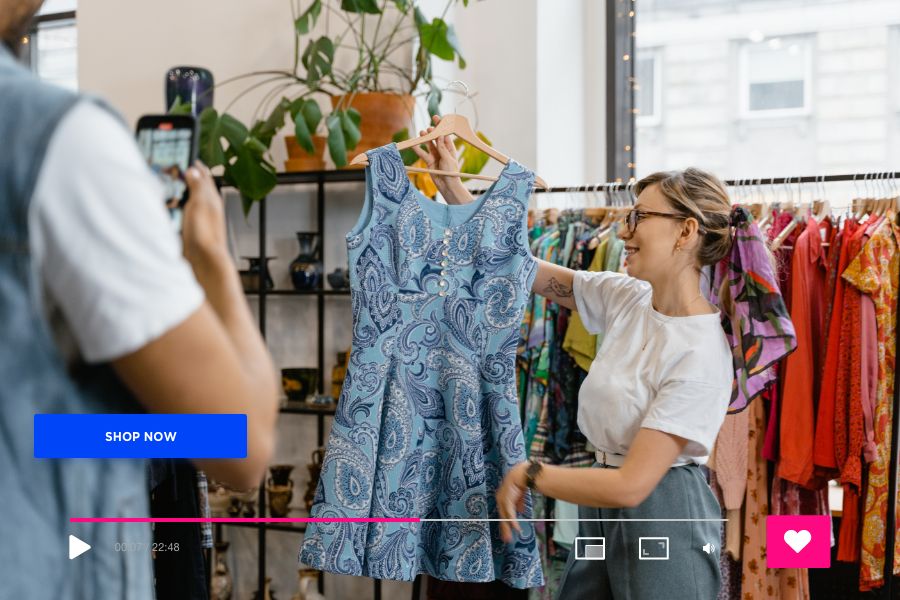
Live stream shopping (or live shopping) allows online shoppers to buy products straight from a live video feed. It adds a human touch to eCommerce, transforming the shopping journey into an engaging experience.
Live streaming continues to become more and more popular in the online world. Viewers seem to be more interested and engaged while watching live videos compared to videos on demand. Due to its effectiveness and popularity, brands within Asian countries and not only decided to sell their products in a virtual environment, in a format called ‘Live Stream Shopping’.
This concept was introduced by Taobao Live, a company owned by Alibaba, back in 2016. This eCommerce platform sold more than $60 billion through live sales in 2020, an amazing jump from $15 billion in 2018. In response, Amazon developed its own Live Commerce channel, named ‘Amazon Live’. Many consider this to be the future of eCommerce in the US. In this article, we will try to understand what is Live Stream Shopping model and how this trend became so popular.
What is Live Stream Shopping, exactly?
Many relate Live Stream Shopping to the traditional home shopping channels, where viewers can tune in, see what is for sale and proceed with the purchase immediately. Although the concept behind it is quite similar, Live Stream Shopping comes with additional features that make it more appealing and efficient for both end-users and businesses using it.

Key LSS Features
- Live
As the name already suggests, most of the time, Live Stream Shopping is broadcasted in real-time (live). Instead of uploading pre-recorded videos, Live Stream Shopping is designed to keep customers engaged and make promotions available only for the duration of the live stream. It can be presented to a broad audience as a ‘one-time deal’ that might not be available when the stream stops. It creates a psychological effect, called “Fear of missing out” (FOMO). This effect shows an almost immediate reaction, especially among millennial consumers.
- Highly Interactive Content
During shopping sessions, viewers can ask product-related questions and leave comments or chat with one another. This happens while the host presents specific product features. The interactive format makes it a two-way conversation, a big difference from traditional TV shopping. As the ability to speak to a shop assistant is
- Direct shopping option
Live stream shopping allows customers to buy products straight from the live video experience. Unlike traditional TV Shopping where we would have to place an order by phone, Live Stream Shopping leverages the user-friendly eCommerce checkout process. Every product that is presented by the host can be purchased/added to the cart with a simple click. As a customer, you can just buy without having to interrupt the live stream.
- Authenticity of Presented Products
Forget about video editing or Photoshopping. Live platforms provide the authenticity that modern buyers want. With shopping sessions taking place solely live, buyers are inclined to trust sellers, since they are watching them use, wear, and test their list of offerings in real time. On the contrary, traditional TV Shopping products can be very tricky as there is a lot of video editing and special angles involved. You can only be certain regarding the quality of a placed order after it reaches your door. Product authenticity is another important feature that has a positive impact on purchase behavior and satisfaction.
Live Stream Shopping in China
Market analysts predict that just as online shopping transformed retail twenty years ago, live streaming promises to transform e-commerce today. In China, numerous farmers, business owners, and freelancers present their list of offerings through live stream platforms rather than in physical stores. They hire influencers with a well-defined and relevant follower base to act as hosts and test out different products in front of the camera.
In 2019, live streaming commerce surpassed 433 billion yuan ($61 billion) in transactions and as we speak, it is getting a serious boost from the pandemic. In 2020, sales jumped to $240 billion, much more than initially expected ($129 billion). In 2022 it maintained its rapid growth and surpass 3.49 trillion yuan (approximately 423 billion USD).
The Chinese population seems to appreciate the way in which Live Stream Shopping engages them with the product and sometimes with a well-known influencer. They consider the process of purchase to be more social and interactive compared to the traditional way of browsing web pages. And this shows in how shoppers adopt this new way of buying. If in march 2020 the Chinese live stream shopping market had little over 200 million users, by June 2022 they’d reached 469 million. This 2 fold increase means that almost half of the Chinese internet users (44.6%) bought products from a live shopping session.
Adoption in the western markets
While the adoption rate was slower in the US market, this new way of shopping is rapidly getting traction with younger generations. In 2021, the market reached $11 billion, and it’s expected to reach a threefold increase by 2024. However, experts say that by 2026, the live stream shopping market will account for up to 20% of all eCommerce transactions.
In Europe, 7 out of 10 online users are open to buying products from a live shopping event.





